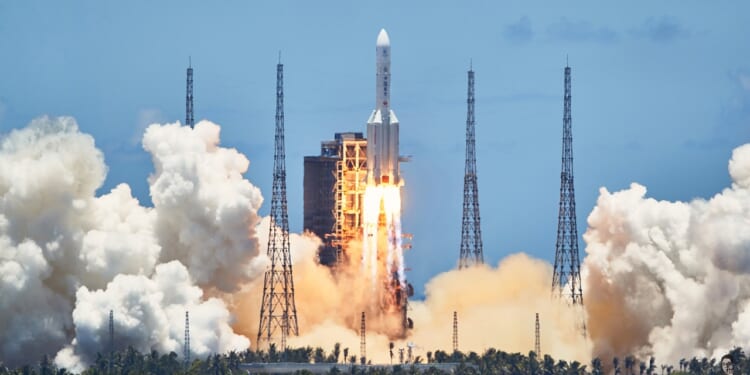SpaceX revolutionized space travel by creating rockets that could be safely recovered after a launch. Now China is attempting to follow suit.
There are fewer technological domains where the Americans are decisively ahead of the Chinese. The one consistent lead the Americans enjoy—mostly thanks to Elon Musk’s SpaceX—is in the arena of reusable rockets. Not even Russia or Europe can compete in this area with the Americans.
Yet, that is set to change. LandSpace, a commercial Chinese space firm, has been desperately trying to catch up with the Americans—especially SpaceX—to better compete for contracts in space. The firm’s other implicit goal is to give the Chinese military strategic advantages in the strategic high ground of space, in much the same way that SpaceX has conferred strategic advantages to the US military in space.
LandSpace’s ZQ-3 Reusable Rocket Attempts to Copy SpaceX Tech
Enter LandSpace’s Zhuque-3 (ZQ-3), which is a two-stage orbital launch vehicle. The first stage is designed to be reusable (meaning it is meant to return to the Earth and be used repeatedly). The second stage is not yet reusable—but this is just the start of China’s development of reusable rockets, with the ultimate goal being to have a totally reusable system much like SpaceX and other US firms enjoy.
The body is planned to be built from high-strength stainless steel, a trend in next-generation reusable rockets. Of course—and this is likely true—critics argue that the ZQ-3 is little more than a classic Chinese knockoff of the real thing. In this case, a replica of SpaceX’s Starship.
The fuel the ZQ-3 employs is liquid methane and liquid oxygen for both stages.
Just like SpaceX’s reusable rockets, LandSpace’s ZQ-3 reusable rocket is meant to enable lower-cost, higher-frequency launches (including for large constellations) by reusing hardware and optimizing cost per launch. Despite the criticisms lobbed at the ZQ-3 rocket, Americans would be remiss if they merely wrote it off as just another Chinese knockoff.
Granted, it is a knockoff of an iconic American product. But no other country has managed to copy Starship (or any other SpaceX system, for that matter) other than China, the chief competitor to the United States.
The CCP Supports the ZQ-3’s Development—for Obvious Reasons
The ZQ-3 has been in development and received copious support from the Chinese government in order to fast track its development. Last January, ZQ-3’s vertical takeoff and landing (VTVL) capabilities were tested with a prototype “hopper” vehicle at the Jiuquan Satellite Launch Center in China. That test was a success.
Then, in September 2024, LandSpace conducted a higher-altitude VTVL test. At that test, the firm shut down the engine in order to see how the craft glided. The engines were then restarted, and the engineers tested the powered landing system.
In June of this year, a major ground static fire test for the first-stage propulsion cluster of nine engines at the Dongfeng commercial space innovation pilot zone near Jiuquan was tested. That experiment lasted around 45 seconds. About a week ago, the ZQ-3 completed final tests ahead of its maiden flight—scheduled for late this year—including full propellant-loading rehearsal and static fire.
A launch involving the recovery of the first stage of the ZQ-3 rocket will be conducted at some point next year after it successfully completes its maiden flight in the next couple of months in China.
Interestingly, the Chinese are pushing back the recovery of the reusable first stage until next year. Recovery of the first stage is a non-trivial matter. The whole point of reusable rockets is to conduct reliable, safe landings, to refurbish those rockets, and then quickly redeploy those rockets. The hopper tests conducted in 2024 were promising, since, as SpaceX has shown, orbital stage recovery is much harder.
The ZQ-3 Could Give America a Real Competitor in Space
What’s more, even if SpaceX manages to successfully land their first stage rocket, they must show the ability to do so repeatedly for it to be viable from a business perspective (and reliable from a military standpoint).
China has much riding on this system—especially LandSpace. The Chinese domestic market in high-tech generally, but specifically in their space sector, is extremely competitive. There are many other Chinese space firms chomping at the bit to displace LandSpace should its product fail. Nevertheless, this is a significant challenge to SpaceX. If this system by LandSpace works, there will be more innovations. For instance, later versions might use upgraded engines, like the TQ-12B, to enhance their operations.
Should China master this capability, given their all-of-society commitment to space dominance, the Americans will soon have very significant difficulties maintaining the lead in space that they inherited from their Cold War victory decades ago.
About the Author: Brandon J. Weichert
Brandon J. Weichert is a senior national security editor at The National Interest. Recently, Weichert became the host of The National Security Hour on America Outloud News and iHeartRadio, where he discusses national security policy every Wednesday at 8pm Eastern. He is also a contributor at Popular Mechanics and has consulted regularly with various government institutions and private organizations on geopolitical issues. Weichert’s writings have appeared in multiple publications, including The Washington Times, National Review, The American Spectator, MSN, and the Asia Times. His books include Winning Space: How America Remains a Superpower, Biohacked: China’s Race to Control Life, and The Shadow War: Iran’s Quest for Supremacy. His newest book, A Disaster of Our Own Making: How the West Lost Ukraine is available for purchase wherever books are sold. He can be followed via Twitter @WeTheBrandon.
Image: Shutterstock / Qing-lin.


















